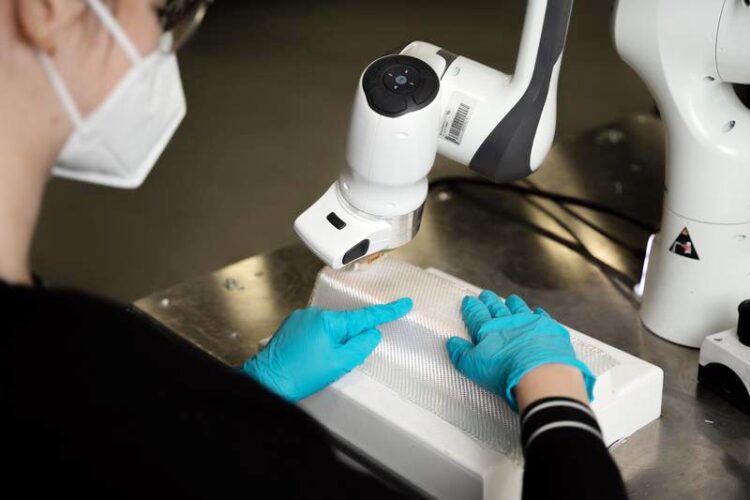Test live robotic draping of reinforcement textiles

Human and robot jointly drape reinforcement textiles
Credit: ITA Institut für Textiltechnik of RWTH Aachen University
… at JEC World 2022 in Paris.
The ITA Institut für Textiltechnik of RWTH Aachen University will present a collaborative robot (cobot) including tools for semi-automated draping of reinforcement textiles at JEC World 2022 in Paris. The cobot is used without additional safety measures such as protective fences or light barriers thanks to integrated sensor technology. It can thus collaborate directly with human.
Another ITA exhibit is a demonstrator for mobile hydrogen storage in the form of a Type-4 pressure vessel made of fibre-reinforced composites (FRP).
Added value through joint draping of humans and robots
ITA has developed tools that allow joint draping of textiles by humans and cobots. In addition to increasing draping quality and reproducibility, the focus in development was on occupational safety.
Other advantages of this new type of robot-assisted draping are that cobots are inexpensive to procure and easy to program. This results in great flexibility in manufacturing and the possibility to produce small to medium quantities in an automated way.
How can these advantages be exploited in the production of fibre composite components? This is what ITA is investigating, for example in the handling, draping and joining of the sensitive, limp textile material. At the JEC, visitors will have the chance to interact live with the cobot and experience collaborative draping first hand.
Demonstrator for mobile hydrogen storage
Another ITA exhibit is a demonstrator for mobile hydrogen storage in the form of a Type-4 pressure vessel made of fibre-reinforced composites (FRP). It is based on a specially developed liner concept and was manufactured using the multi-filament winding process with towpregs. The exhibit is additionally equipped with fibre optic sensors for strain and temperature monitoring. This enables condition monitoring through structural health monitoring.
Background
ITA will be demonstrating its expertise in the field of composite materials at the joint stand of the Aachen Center for Lightweight Construction (AZL) in Hall 6, Stand S50. It will present innovations and research priorities in the production of reinforcing fibres, the textile processing of such high-modulus fibres and the impregnation of high-performance modulus fibres with thermoset as well as thermoplastic matrix systems. The ITA will show the entire process chain, from fibre production and processing to the finished component, and will thus be able to present and discuss promising innovations at all levels. It illuminates the issues of composite production and processing from the textile side. The institute’s expertise lies in the characteristics of reinforcement and matrix materials, load-oriented textile processing and the manufacture of components made of continuous fibre-reinforced plastics.
The Aachen Center for Lightweight Construction (AZL) as a superordinate partner as well as the partner institutes and companies at the booth cover further topics of FRPs. These are, for example, the load-compliant design of components, plastics-side processing, and extensive testing of components.
Wissenschaftliche Ansprechpartner:
Cobot:
Hannah Dammers
Scientist at ITA Institut für Textiltechnik of RWTH Aachen University
Phone: +49 241 80 22095
Email: hannah.dammers@ita.rwth-aachen.de
Demonstrator for mobile hydrogen storage
Oscar Bareiro
Scientist at ITA Institut für Textiltechnik of RWTH Aachen University
Phone: +49 241 80 24724
Email: oscar.bareiro@ita.rwth-aachen.de
Media Contact
All latest news from the category: Materials Sciences
Materials management deals with the research, development, manufacturing and processing of raw and industrial materials. Key aspects here are biological and medical issues, which play an increasingly important role in this field.
innovations-report offers in-depth articles related to the development and application of materials and the structure and properties of new materials.
Newest articles

A universal framework for spatial biology
SpatialData is a freely accessible tool to unify and integrate data from different omics technologies accounting for spatial information, which can provide holistic insights into health and disease. Biological processes…

How complex biological processes arise
A $20 million grant from the U.S. National Science Foundation (NSF) will support the establishment and operation of the National Synthesis Center for Emergence in the Molecular and Cellular Sciences (NCEMS) at…

Airborne single-photon lidar system achieves high-resolution 3D imaging
Compact, low-power system opens doors for photon-efficient drone and satellite-based environmental monitoring and mapping. Researchers have developed a compact and lightweight single-photon airborne lidar system that can acquire high-resolution 3D…





















